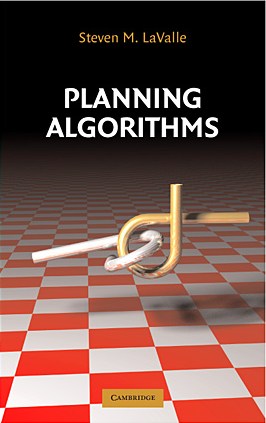
Planning Algorithms
Presents a unified treatment of many different kinds of planning algorithms. The subject lies at the crossroads between robotics, control theory, artificial intelligence, algorithms, and computer graphics.
Tag(s): Computer Vision
Publication date: 01 Jun 2006
ISBN-10: 0521862051
ISBN-13: n/a
Paperback: 842 pages
Views: 23,249
Planning Algorithms
 Presents a unified treatment of many different kinds of planning algorithms. The subject lies at the crossroads between robotics, control theory, artificial intelligence, algorithms, and computer graphics.
Presents a unified treatment of many different kinds of planning algorithms. The subject lies at the crossroads between robotics, control theory, artificial intelligence, algorithms, and computer graphics.
Tag(s):
Computer Vision
Publication date: 01 Jun 2006
ISBN-10: 0521862051
ISBN-13: n/a
Paperback: 842 pages
Views: 23,249
Document Type: N/A
Publisher: Cambridge University Press
License: n/a
Post time: 07 Aug 2006 08:00:28
Publication date: 01 Jun 2006
ISBN-10: 0521862051
ISBN-13: n/a
Paperback: 842 pages
Views: 23,249
Document Type: N/A
Publisher: Cambridge University Press
License: n/a
Post time: 07 Aug 2006 08:00:28
Book Excerpts:
What is a planning algorithm? This is a difficult question, and a precise mathematical definition will not be given in this book. Instead, the general idea will be explained, along with many examples of planning algorithms.
Planning is a term that means different things to different groups of people. A fundamental need in any process of automation is to have algorithms that convert high-level specifications of tasks from humans into low-level descriptions of how to move. The terms motion planning and trajectory planning are often used for these kinds of problems.
A classical version of motion planning is sometimes referred to as the Piano Mover's Problem. Imagine giving a precise computer-aided design (CAD) model of a house and a piano as input to an algorithm. The algorithm must determine how to move the piano from one room to another in the house without hitting anything. Motion planning usually ignores dynamics and other differential constraints and focuses primarily on the translations and rotations required to move the piano. Recent work, however, does consider other aspects, such as uncertainties, differential constraints, modeling errors, and optimality. Trajectory planning usually refers to the problem of taking the solution from a motion planning algorithm and determining how to move along the solution in a way that respects the limitations of the automation.
Why study planning algorithms?
There are at least two good reasons. First, it is fun to try to get machines to solve problems for which even humans have great difficulty. This involves exciting challenges in modeling planning problems, designing efficient algorithms, and developing robust implementations. Second, planning algorithms have achieved widespread successes in several industries and academic disciplines, including robotics, manufacturing, drug design, and aerospace applications. The rapid growth in recent years indicates that many more fascinating applications may be on the horizon. These are exciting times to study planning algorithms and contribute to their development and use.
What is a planning algorithm? This is a difficult question, and a precise mathematical definition will not be given in this book. Instead, the general idea will be explained, along with many examples of planning algorithms.
Planning is a term that means different things to different groups of people. A fundamental need in any process of automation is to have algorithms that convert high-level specifications of tasks from humans into low-level descriptions of how to move. The terms motion planning and trajectory planning are often used for these kinds of problems.
A classical version of motion planning is sometimes referred to as the Piano Mover's Problem. Imagine giving a precise computer-aided design (CAD) model of a house and a piano as input to an algorithm. The algorithm must determine how to move the piano from one room to another in the house without hitting anything. Motion planning usually ignores dynamics and other differential constraints and focuses primarily on the translations and rotations required to move the piano. Recent work, however, does consider other aspects, such as uncertainties, differential constraints, modeling errors, and optimality. Trajectory planning usually refers to the problem of taking the solution from a motion planning algorithm and determining how to move along the solution in a way that respects the limitations of the automation.
Why study planning algorithms?
There are at least two good reasons. First, it is fun to try to get machines to solve problems for which even humans have great difficulty. This involves exciting challenges in modeling planning problems, designing efficient algorithms, and developing robust implementations. Second, planning algorithms have achieved widespread successes in several industries and academic disciplines, including robotics, manufacturing, drug design, and aerospace applications. The rapid growth in recent years indicates that many more fascinating applications may be on the horizon. These are exciting times to study planning algorithms and contribute to their development and use.
Tweet
About The Author(s)
No information is available for this author.
Book Categories
Computer Science
Introduction to Computer Science
Introduction to Computer Programming
Algorithms and Data Structures
Artificial Intelligence
Computer Vision
Machine Learning
Neural Networks
Game Development and Multimedia
Data Communication and Networks
Coding Theory
Computer Security
Information Security
Cryptography
Information Theory
Computer Organization and Architecture
Operating Systems
Image Processing
Parallel Computing
Concurrent Programming
Relational Database
Document-oriented Database
Data Mining
Big Data
Data Science
Digital Libraries
Compiler Design and Construction
Functional Programming
Logic Programming
Object Oriented Programming
Formal Methods
Software Engineering
Agile Software Development
Information Systems
Geographic Information System (GIS)
Mathematics
Mathematics
Algebra
Abstract Algebra
Linear Algebra
Number Theory
Numerical Methods
Precalculus
Calculus
Differential Equations
Category Theory
Proofs
Discrete Mathematics
Theory of Computation
Graph Theory
Real Analysis
Complex Analysis
Probability
Statistics
Game Theory
Queueing Theory
Operations Research
Computer Aided Mathematics
Supporting Fields
Web Design and Development
Mobile App Design and Development
System Administration
Cloud Computing
Electric Circuits
Embedded System
Signal Processing
Integration and Automation
Network Science
Project Management
Operating System
Programming/Scripting
Ada
Assembly
C / C++
Common Lisp
Forth
Java
JavaScript
Lua
Rexx
Microsoft .NET
Perl
PHP
R
Python
Rebol
Ruby
Scheme
Tcl/Tk
Miscellaneous
Sponsors
